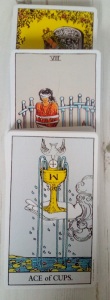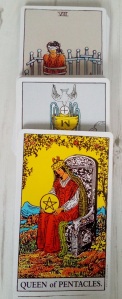Greetings To All,
This week I will be covering the Giant-Rider Waite Tarot Deck and its many uses. In this series of posts, I will demonstrate how I use this deck both on a personal level and within my practice.
Enjoy,
xxx Vivien (your tarot teacher)
Giant Rider-Waite Tarot Deck: Complete 78-Card Deck
We are all familiar with the standard size Rider-Waite tarot cards (7 cm x 12 cm) because these are the most commonly used deck when learning to read tarot. The standard size can be tricky enough to control when handling and shuffling, but there is also a Giant, in your face size version, measuring in at a whopping 10 cm x 17 cm with rich colouring and strong defined imagery. As mentioned already, you will find that people generally struggle when shuffling the regular size cards as they are considered just that little bit too big for easy handling, yet we manage to work around it. We might wonder then why one would want to make life harder by struggling with an even larger deck? There are also mini versions available which some readers find useful for carrying around in their handbag or pocket, but I wouldn’t recommend them for those new to the study of tarot as you may not be able to discern or appreciate the full detail of the imagery vital for interpretation. They are however perfect for experienced readers who are very familiar with their imagery. Of course, several non Rider-Waite decks have been designed with more efficient handling and shuffling dimensions, The Spiral Tarot being a perfect example. As for me, I am petite both in stature and hand size, but the first time I came upon The Giant Rider Waite Deck, I knew I had to have them as I could see the many purposes they would serve. I have since discovered that many readers declare them their card size of choice. So, why might this be? Well I can only speak for myself.
Shop For Giant Rider-Waite Tarot Deck
Giant Rider-Waite Tarot Deck: Complete 78-Card Deck
Excellent Teaching Aid
The Main reason I purchased the Giant Rider-Waite Tarot Deck was for teaching purposes. I was running weekly evening Tarot Classes from a log cabin at the rear of my garden. My small group of students would huddle around the table as I described the imagery in the cards. Students were required to have their own standard size deck to bring to class for following each card as it was taught.
In the regular size Rider-Waite, the detail is all there, along with the colours, symbolism and props that weave together in telling their personal story. Of course, all this detail is easy to see when you know what you are looking for or have become familiar with from constant use and practice. In general, those new to tarot fail to notice the intricate detail of the imagery, taking note only on a superficial level. They look at the picture, see what they see, or see what they think they see, and decide there is nothing more to see, as they have seen all there is to see. They look, but they don’t look deeply enough. An acquired vision is required. They sum up the imagery quite rapidly, not allowing for the subtle innuendos that whisper forth if only they would linger a while longer. I would send my students back again and again to the imagery to inspect it thoroughly, for they were giving only a fraction of what was waiting to be found. Once I had exhausted them with this tedious exercise, I would then lay the Giant Size Version of the card on the table and begin to dissect it bit by bit. My students would lean over and gasp at the missing bits of information I pointed out, puzzled about how they had overlooked them, even after what they considered to be a ruthless search.
In the early days of their tarot study, their summary of imagery on any particular card was generally basic and limited. There were always one or two though who would approach it as a challenge or competition to see more than the others could. They would come up with some gems, similar to the sale shopper who systematically works through every rail in search of a great find or bargain, rather than conduct a quick drive-by or glance-over declaring there, ‘to be nothing worth looking at’. Some of the best finds are to be found hidden or concealed behind more mundane items. It is only by rooting through the lot do they eventually surface. It also reminds me of my son when he had to compose sentences for homework. For example, he might have been given a list of words with each one needing to be incorporated into a sentence. He was a great man for cutting corners and taking the easiest route to the finish line – he hated homework! I would call out the word and he had to make up the sentence. I would give him the word ‘Ball’ and he would think about it for all of 2 seconds before coming up with the profound likes of ‘I have a ball’, or ‘ I saw a ball’. I would groan and warn him that his teacher would fall asleep listening to such unimaginative use of words. He might then come back with what he considered something far more complex, such as ‘The boy has a ball’ or I have a red ball’. ‘Wow, fascinating’ I would reply. I would send him back and tell him to come up with something a little more interesting, leaving him moaning and groaning about how unfair it all was.
The point in all this is to wring as much out of the card imagery as possible. It is only through application to this endeavor will you become familiar with the cards. However, certain detail in the imagery will only reveal itself to you as your tarot studies mature – it takes time. The vision required for thoroughly analysing tarot card imagery is something that evolves and cannot be fast-tracked. You won’t find a step-by-step guide in any book. Not one that works anyway. You will find pointers and be presented with things to consider, but not a formula for getting from a to b. Of course, some are naturally better at this than others. A a teenager, I remember thoroughly enjoying my English homework assignments when we had to write a summary, personality analysis or essay about a book or poem we were studying. I really enjoyed this work, as whereas I had to know the book to write about it, I could also give my personal interpretation of it, my thoughts and feelings about story lines, impressions of characters and the aptness of scenes portrayed. I was actively encouraged to consult my inner vision. I was asked for my opinion just as much as I was asked to recount the facts of the book. My school mates would fall into despair, especially during exam time. They could prepare for many subjects, learn by rote what was needed to pass an exam, but this kind of request required them to engage on a level that felt like pulling teeth. Activating their inner-vision or imagination was just too tedious. Relying solely on what they could consciously remember from the story line and characters, they found it intensely difficult to write the number of words required for the homework or exam.
Practice and and time sharpens both the conscious and subconscious vision. A bit like comparing the difference between viewing the card imagery with and without your reading glasses on. In the case of tarot imagery, you need to strengthen both your physical and metaphysical vision, put your tarot spectacles on. You need to combine both a conscious acknowledgement of what you physically see with your eyes, what your brain is telling you you see, with that which your subconscious or inner vision conjures up. The psychical vision permits you to stand apart from the imagery, view it remotely. You can describe it in a third-party manner. You are observing the imagery, but are not part of it. You are relaying a description or statement about something that is apart from you. This leads to being able to apply a consciously descriptive and analytic narrative as you convey the facts of the imagery before you. In this case, the ball is exactly as my son described it, a ball. When you subconsciously view, use your inner vision, you become part of the imagery. It is going on around you, you are there. Your senses are involved in it on every level. You are one with the imagery. When the inner-vision is used to describe the imagery, emotion and imagination are added to the facts. The ball came from somewhere. Where? Who might own the ball? Where are they, what happened to them? What is the ball doing there? What will happen to the ball next? You have to imagine what these answers might be. We cannot use facts to determine these matters for nowhere in the imagery can we find it. We can only surmise and guess. To do this, we must make up a story around the ball. The imagination is used to create the story and once the imagination is engaged, the internal eye will flicker open and present us with visuals to accompany our musings. We can now see a lot more than what we initially saw. Inanimate or mundane objects take on a new life, or in some cases, come to life. We enter the realm of Alice in Wonderland after she falls down the rabbit hole. When I ask my students to tell me what they see in the imagery of the tarot card we are looking at, I am not solely seeking what they can physically observe. Yes, that will do for starters, but alone is flat and limiting. I want the dynamic, three-dimensional version, the one that might spring to life if Alice in Wonderland was to take it in her hand.
The imagery in any card of the tarot is but a still from a movie or video clip. It gives a brief snapshot of what is happening, but relying entirely upon the still will yield only generic information. You need to press the Play Button to get the full impact. You also need to rewind a bit to discover the lead up to the still, which then nicely sets up where the imagery might be heading next. Where learning tarot is concerned, you do not have the physical presence of a Play or Rewind button to navigate with. Instead you must rely on both your conscious and subconscious vision to do this for you. Those new to tarot can find this hard to accept. They ask for exact instructions on how to do it, or for a list of observations the subconscious might see to save them having to engage their own. The thing is, I can give them my list. It will certainly help, but it does not belong to them. They must find a way to initiate this combined process for themselves. Combining both the conscious and subconscious, physical and metaphysical vision is also vital to the process of connecting and linking cards in a Spread. There is no cut and dry, just add hot water and stir way of doing this.
The Giant Rider Waite can facilitate the process by blowing the picture up, and bringing imagery into sharp focus. With more to work with, it is easier to discern things not obvious before. Interacting with the imagery in the large cards becomes more accessible. It’s as if the scenes and characters of the Tarot move from the small stage onto the large screen in high-definition. In the Giant Rider-Waite, they become larger than life figures with strong stage presence. They turn into poster pin-up icons and billboard stars that captivate and draw us in. Alice in Wonderland sees them as living and breathing entities.
When using Giant Rider Waite for teaching, we must also consider the slight variations from one edition of Rider-Waite to the next, and also the strength and tone of colouring. The deck your students use, might be slightly different in presentation. Similar to the way colours alter when rendered in different browser windows, Rider-Waite colouring can vary from version to version. However, the theme remains the same, the detail intact. The very size of the Giant cards help zoom in on areas of special interest to investigate forensically. We can examine the facial features of the characters in greater depth, decide upon demeanor and attitude from the set of their jaw and intensity of gaze. We can study their physique and detail their attire. The environment captured in the imagery offers up minute detail that can become obscure when image size is reduced. We can see exactly what is depicted; crowns, carved into thrones, rings on fingers, emblems on clothing, crests on walls and creatures amidst the grass. They provide the fodder that our subconscious and imagination require to kick-start collaborative engagement.
The Giant Rider-Waite Cards are invaluable when teaching. Even when standing at the top of the class holding up a card for analysis and discussion, the students can discern the imagery and detail I am referring to without the need to crowd around it. I typically cover a few cards per class session and then place the Giant Cards on the center of the table for all to view. It is not necessary for each student to pick the card up individually for closer inspection, as they can see clearly from a distance. As a teacher, it makes my work much easier. There is less of the squinting and scrutinising that is common when teaching from the regular size deck.
Shuffling Giant Rider-Waite Cards
Because of the large size of the Giant Rider Waite cards, it is not possible to shuffle them in the normal manner, which for most people is on their side horizontally. Instead, the preferred method is to shuffle them vertically by standing them upright on a surface, or in your hands, and lifting groups of cards over, behind and between each other. This is a slower method than horizontal shuffling, so extra time should be given to adequately infuse the cards with the energy of the query. Some may choose to spread the deck face down on a large table and mix them up with their hands. If choosing this method and not Reversing cards, care should be taken not to lose orientation of the cards as they can be quite slippy.
Shop For Giant Rider-Waite Tarot Deck

****************
Giant Rider-Waite Posts Coming This Week
Enhancing Personal Tarot Study With Giant Rider-Waite Cards
Creative Uses For Giant Rider-Waite Cards
Personality Profiling With Giant Rider-Waite Cards (plus step-by-step guide)
Giant Rider-Waite Personality Profile Example
***************************
Work Continues on:
Wands’s Encyclopedia of Love & Sex – Installment 3b -The Six of Wands
Re-working The Emperor and The Hierophant
Categories: Course Update, Personal Stories, Uncategorized











Looking forward to this thanks for all the hard work you put into all this
LikeLiked by 1 person
When I taught the basic course at TABI, I would ask the students to pick their cards and write descriptions in excruciating detail. It gets people to really see a card.
Great post – I would love giant versions of a few of my favourite decks.
LikeLike
Yes Bev, I am a bit of a Ms. Pedantic when it comes to descriptions and excruciating detail. I agree students need to be challenged to see more than they think they see. The only way to learn is through persistent application. you sound like my kind of teacher X
LikeLike
I just discovered your section on the Kabbalah, do you have plans to continue these Lessons? Very Excited for them 🙂 thanks
LikeLike
Hi,
Thank you for showing your interest in my work. Believe me, I have plans to continue creating further content in all areas. Will get to everything hopefully.
Blessings,
VIvien
LikeLike
I have the giant deck. Never really looked at it the way you described. I am going to immediately take it out now, and have a go at it. Thanks.
LikeLiked by 1 person
Oh I hope I haven’t given you extra work Carole!!
LikeLike